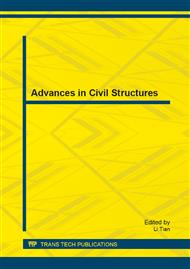p.297
p.305
p.309
p.315
p.319
p.325
p.329
p.337
p.342
Study on Flexural Stiffness Reduction Factor of Reinforced Concrete Column with Equiaxial T Shaped Section
Abstract:
The reduced stiffness method had been adopted to evaluate the material nonlinearity characteristics of reinforced concrete structures to be in compliance with concrete structure standards of the United States, New Zealand and Canada. Concrete structure design code in China also accepts the reduced stiffness method as a supplementary method of considering the second-order effects problem. However, the concrete structure with specially shaped columns code of China still use amplified coefficients of eccentricity to consider nonlinearity characteristics of reinforced concrete structure with special shaped columns. Based on the numerical integral method, a flexural stiffness reduction factor is proposed to consider characteristics of material nonlinearity and geometrical nonlinearity of reinforced concrete columns with equiaxial T shaped section.
Info:
Periodical:
Pages:
319-324
Citation:
Online since:
August 2013
Authors:
Price:
Сopyright:
© 2013 Trans Tech Publications Ltd. All Rights Reserved
Share:
Citation:


